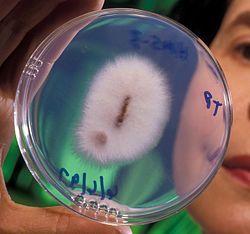Fusarium oxysporum
| Fusarium oxysporum | |
|---|---|
 |
|
| Scientific classification | |
| Kingdom: | Fungi |
| Division: | Ascomycota |
| Class: | Sordariomycetes |
| Order: | Hypocreales |
| Family: | Nectriaceae |
| Genus: | Fusarium |
| Species: | F. oxysporum |
| Binomial name | |
|
Fusarium oxysporum Schlecht. emend. Snyder & Hansen |
|
The ascomycete fungus Fusarium oxysporum ![]() Fusarium Oxysporum Schlecht as emended by Snyder and Hansen comprises all the species, varieties and forms recognized by Wollenweber and Reinking within an infrageneric grouping called section Elegans. While the species, as defined by Snyder and Hansen, has been widely accepted for more than 50 years, more recent work indicates this taxon is actually a genetically heterogeneous polytypic morphospecies whose strains represent some of the most abundant and widespread microbes of the global soil microflora, although this last statement has not been proven or supported by actual data. These remarkably diverse and adaptable fungi have been found in soils ranging from the Sonoran Desert, to tropical and temperate forests, grasslands and soils of the tundra.F. oxysporum strains are ubiquitous soil inhabitants that have the ability to exist as saprophytes, and degrade lignin and complex carbohydrates associated with soil debris. They are also pervasive plant endophytes that can colonize plant roots and may even protect plants or be the basis of disease suppression. Although the predominant role of these fungi in native soils may be as harmless or even beneficial plant endophytes or soil saprophytes, many strains within the F. oxysporum complex are pathogenic to plants, especially in agricultural settings.
Fusarium Oxysporum Schlecht as emended by Snyder and Hansen comprises all the species, varieties and forms recognized by Wollenweber and Reinking within an infrageneric grouping called section Elegans. While the species, as defined by Snyder and Hansen, has been widely accepted for more than 50 years, more recent work indicates this taxon is actually a genetically heterogeneous polytypic morphospecies whose strains represent some of the most abundant and widespread microbes of the global soil microflora, although this last statement has not been proven or supported by actual data. These remarkably diverse and adaptable fungi have been found in soils ranging from the Sonoran Desert, to tropical and temperate forests, grasslands and soils of the tundra.F. oxysporum strains are ubiquitous soil inhabitants that have the ability to exist as saprophytes, and degrade lignin and complex carbohydrates associated with soil debris. They are also pervasive plant endophytes that can colonize plant roots and may even protect plants or be the basis of disease suppression. Although the predominant role of these fungi in native soils may be as harmless or even beneficial plant endophytes or soil saprophytes, many strains within the F. oxysporum complex are pathogenic to plants, especially in agricultural settings.
Because the hosts of a given forma specialis usually are closely related, many have assumed that members of a forma specialis are also closely related and have descended from common ancestor. However, results from recent research conducted on *Fusarium oxysporum f. sp. cubense have forced scientists to question these assumptions. Researchers used anonymous, single-copy restriction fragment length polymorphsims (RFLPs) to identify 10 clonal lineages from a collection of F. oxysporum f.sp. cubense from all over the world. These results showed that pathogens of banana causing Panama disease could be as closely related to other host's pathogens, such as melon or tomato, as they are to each other. Exceptional amounts of genetic diversity within F. oxysporum f.sp. cubense also have been deduced from the high level of chromosomal polymorphisms found among strains, random amplified polymorphic DNA fingerprints, and from the number and geographic distribution of vegetative compatibility groups.
...
Wikipedia
